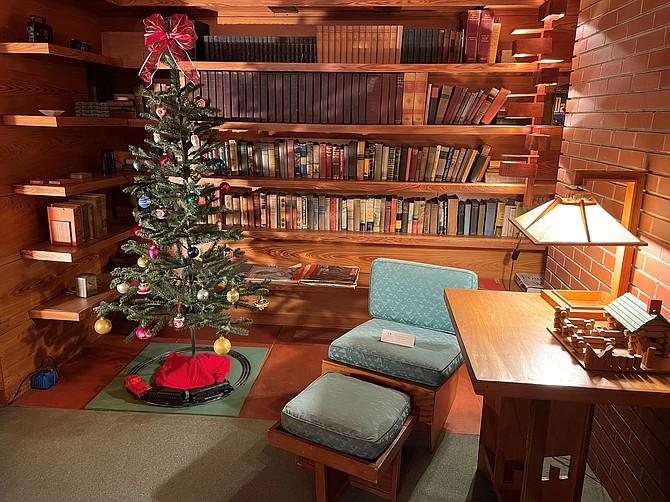A three-car, Lionel model electric train with a red caboose buzzes around a 28-inch-diameter track under the six-foot Christmas tree decorated with gleaming vintage glass ornaments. Bing Crosby croons “Silver Bells” from a 33, long-playing record spinning on a turquoise, 1950s replica record player.
For the first time ever, the Pope-Leighey House at Woodlawn, a house designed by architect Frank Lloyd Wright, is featuring mid-20th-century holiday decorations like those of the historic home’s former owners.
In keeping with the house’s style, the holiday décor is uncluttered and simple, by many standards, today’s and Victorian era, for example. No plastic Santas or glittery snowflakes. No bulging mistletoe balls with shiny trailing ribbons. The tree in the living room, standing where former residents, the Leigheys, put it has about 30 glass ornaments, most of them round, tennis-ball size. The children’s bedroom is brightened with colorful, handmade construction paper chains stretched out just below the ceiling. Outside, period lights line the carport and overhang.
In the office, from a 1950s-1960s, sparkly silver tinsel tree, topped with a red bow, dangle more glass ornaments.
“It is a Space Age tree,” explains Shawn Halifax, Woodlawn’s Executive Director, and some celebrants in its day put a color wheel under it to reflect the glass ornaments.
The minimal decorations are consistent with Wright’s design, a practical, minimalist house. Wright thought that “Americans had too much clutter,” said Amanda Roper, Senior Manager of Public Programs and Interpretation. The house has little storage space so the owners could not store large accumulations.
Roper explained that because curators had few records and no photographs of the former residents’ decorations, the staff researched popular trends of the 1950s and 1960s. She gleaned some facts from the residents’ descendants. The second owners were Robert and Marjorie Leighey. A grandson of Marjorie’s niece remembered the Lionel train under the tree. Another descendant identified the tree’s location.
The original owners of the house, Lauren and Charlotte Pope, decorated with greenery, probably pine and holly branches from their Falls Church, 1.3-acre, woodsy lot, the house’s original location. They lived there between 1942 and 1949 and bought their son a train.
“It feels like a home,” said Roper. “Many people can relate to it. People can explore the time period and its aesthetic.” Comparing it to other historic sites or traditional house museums that are often heavily decorated for the holidays, “It can be nostalgic for some people,” she said. “It’s something different.”
The House’s History
The Pope-Leighey house is one of the famed architect’s Usonian houses, designed to be affordable, middle-class housing. Lauren Pope could not afford a typical Wright home, going then for around $650,000 in today’s dollars. Pope, a journalist, asked Wright to design a house for $5,500, equivalent to $86,000 today. It ended up costing $7,000, including the furniture and Wright’s fee.
The house, at 1,200 square feet, has two bedrooms and one bath on one floor. It’s made of bricks, wood, concrete and glass with no drywall, paint or plaster. “The entire house is a study in horizontality, with its flat, cantilevered roof, horizontal board-and-batten walls and built-in bookcases with no vertical support beams,” wrote Lauren Walser in a 2017 Preservation Magazine article.
Much of the interior is made of natural, honey-colored, cypress wooden planks. Wright did not want the interior to be a series of boxy rectangles. The central living-dining area is an open-floor plan, a combined library and living room with a table for meals or games. Clearstory windows make rooms feel bigger. The kitchen is intended for use by one person.
Wright integrated furniture into the home’s design, to make it blend in and not dominate a space. He designed the beds to be low and without box springs. The doorknobs are unusually high, a form of childproofing, again, the practical touch.
Wright sought to “build with nature rather than against it,” he said, so he included floor-to-ceiling windows leading to an outdoor patio connecting the inside to nature. To enhance affordability, Wright’s design has no gutters, basement, garage or attic.
Robert and Marjorie Leighey lived in the house from 1947 to 1983. The living room was smack in the path of a planned expansion of Interstate 66, so Mrs. Leighey gave the property to the National Trust for Historic Preservation to save it. The Trust moved it to Woodlawn in 1964 and granted her life-time tenancy. She lived there until her death in 1983. Because of the unstable clay soil, Woodlawn’s managers moved it 30 feet uphill in 1995-1996.
“Every home should be as unique as the people living in it,” Wright maintained.

